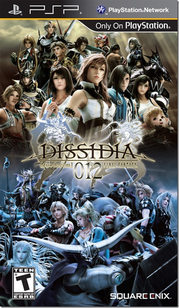
Dishidia Duodeshimu Fainaru Fantajī,? pronounced "Dissidia Duodecim Final Fantasy") is an upcoming 2011 fighting game published by Square Enix for the PlayStation Portable as part of the Final Fantasy series. IThe divine conflict between harmony and discord rages on, the fate of the world its promised prize. Fighting to secure it are brave souls summoned for that solitary purpose. These warriors, relying on what fragments of their shattered memories remain, fight to end the conflict -- and for a chance to return home, to the worlds they each once knew.
Release Date: March 22, 2011
Exclusively on: PSP
T for Teen: Fantasy Violence, Mild Language, Partial Nudity, Suggestive Themes
Genre: Action RPG
Publisher: Square Enix
Developer: Square Enix
Release Date: March 22, 2011
Exclusively on: PSP
T for Teen: Fantasy Violence, Mild Language, Partial Nudity, Suggestive Themes
Genre: Action RPG
Publisher: Square Enix
Developer: Square Enix
The Review:
Gameplay is largely reminiscent of Dissidia: Final Fantasy along with a few changes. The game consists primarily of one-on-one battles, taking place on what's known as a battle map where the two characters duel. Players are able to perform two types of attacks: a Bravery attack and an HP attack. Both characters start with a set amount of Bravery points, the number of Bravery points being equivalent to the amount of damage dealt by an HP attack. Thus, the player must perform several Bravery attacks to steal Bravery points from the opponent so as to increase the power of their HP attack, as Bravery attacks do not cause any damage.
The mechanics of the battle system include "EX Mode" and "Assist." EX Mode functions exactly the same as the first game by collecting EX Cores around the battle map to fill up the EX gauge and transform the character into a more powerful state, which allows players to perform a powerful EX Burst attack should an HP attack land during EX Mode. The Assist system is a new element to the game which allows the player to summon an additional ally into battle to either assist in attacking the enemy or defend from an oncoming attack. It is performed using the Assist Gauge, which is built up by using Bravery Attacks. Both modes are supposed to balance each other, because when an EX Burst is executed, the opponent's Assist Gauge is reduced to zero.
The three main countering systems are Assist Breaks, EX Breaks and EX Revenge. An Assist Break is performed by attacking the opponent's Assist character, causing him/her to be unable to call out the Assist character for a brief period; this also passes the opponent's Bravery points to the character. An EX Break is performed by stopping an opponent's EX Mode through the use of an Assist attack which forces the opponent out of EX Mode, additionally passing the opponent's Bravery points to the player. Lastly, EX Revenge occurs when trying to activate EX Mode while being attacked. While in the first game it would simply halt the opponent's attack, it now slows down time allowing the player to pummel the opponent instead, though it sacrifices the player's ability to use an EX Burst as it uses up the entire EX Gauge.
The biggest addition is within the single-player story mode of the game, taking place on a traditional-styled Final Fantasy world map, with players being able to experience a story while exploring a world with scenarios and events taking place as the story progresses. Players traverse the 3D world map with parties consisting of up to three characters, with players being able to interact in conversations with the characters. When roaming the map, players will encounter enemies known as "Manikins"; when attacked by an enemy, players will be transported to a battle map where battles will take place. There are specially marked shops on the map. The story mode is also party based, similar to the story progression of Final Fantasy VI. In certain scenarios, parties will be predetermined, but in most cases players are free to select their own party. Alongside the game's new story mode, the game also includes the first game's story, which has been remade with the 3D world map as well as additional elements added for the new storyline. Tetsuya Nomura, producer and character designer for the game, has said that both storylines played together would result in approximately 60 hours of gameplay.
Final Thoughts:
t's intimidating and difficult at first, but the end result is always worth the effort. If you're the patient sort that doesn't mind experimenting, Duodecim is hugely rewarding and could be one of the best additions to your PSP library. The story mode should be taken with a grain of salt, but everything else you'll find here is well worth the price of admission. I sank more than 100 hours into the original Dissidia, and it's not hard to imagine I'll do the same for Duodecim.
Rating: 4.5 = Great
Reccomendation: Absolutely a Buy
 RSS Feed
RSS Feed